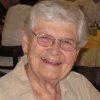Maryknoll Sisters evolve as a multicultural community and microcosm for the world
Long before Pope Francis emphasized that we are all sisters and brothers living on the earth, our common home, the Maryknoll Sisters recognized diversity as enriching the human family.
In 1914 when Elsie St. Clair Davis, a young woman of black and white descent, applied to join the Teresians, the group that would become the Maryknoll Sisters, it was uncommon for women of different races to live together in religious communities. But as the leader of this fledgling community, Molly Rogers had the vision to see that if their mission would be to go to people of other nations, races and cultures, why wouldn’t they welcome women of different ethnic groups who felt called to that same vocation?
Molly put it to her companions to decide if they were willing to accept Elsie into the community. The vote was unanimous, and Elsie became the 14th member of the Teresians. Later given the religious name Sister Mary Francis, she was in the first group of the newly approved Congregation of the Maryknoll Sisters, who, along with Molly (now Mother Mary Joseph) and 12 other sisters, professed first vows on Feb. 15, 1921.
In 1922 Sister Mary Francis was in the second group of Maryknoll Sisters assigned to China and in 1925 was chosen as one of the delegates to attend the First Congregational Chapter. After a life of generous and joyful service, Sister Mary Francis died peacefully at the Sisters’ nursing home, on Oct. 12, 1966.

Sister Mary Francis Davis, the first biracial Maryknoll sister, served in China. (Maryknoll Mission Archives)
In 1924, the first assignments to Korea were made and three Korean women entered the Maryknoll Sisters novitiate in New York. All served as missioners in Asia during World War II and beyond. Among the three was Sister Mary Agneta Chang, sister of John Chang, South Korea’s first ambassador to the United States and later vice president and prime minister of South Korea. Sister Agneta founded the congregation of Sisters of Our Lady of Perpetual Help in Korea in 1932, which thrives today. In 1950 she was arrested by communist soldiers in North Korea and never seen again.
The Maryknoll Sisters recognized the importance of building up the indigenous Church by encouraging young women who felt drawn to religious life to enter communities in their own countries. In their Constitutions they identified the “training of native sisterhoods” as a priority of their mission activity. Between 1926 and 1939 they established six native novitiates: four in China, one in Korea and one in Manchuria, as well as centers for training catechists.
However, the Maryknoll Sisters have also continued to welcome candidates from other countries into their congregation, affirming the conviction expressed by one sister from Tanzania: “God also calls people from my country to cross borders and serve people of cultures not our own.”

Sister Bitrina Kirway from Tanzania currently serves in Hawaii. (Courtesy of Maryknoll Sisters)
Over the years, 316 women from Europe, Asia, Africa and Latin America have become members of the Maryknoll Sisters Congregation, which today includes women from 30 nations. This is over and above the hundreds of North Americans who are children and grandchildren of immigrants to the United States.
What began as a small group of women from Boston seeking to answer Christ’s call to mission has evolved into a multicultural congregation that envisions “One Earth Community,” embracing each other as equals.
Twenty Maryknoll Sisters—from the United States and other countries—recently shared their feelings about being multicultural. The Americans all said the congregation has been blessed to have women from other nations, but also acknowledged that there are challenges that result from diversity.
Language differences can lead to misunderstandings, the sisters pointed out, adding that trust and patience are needed to dialogue with a listening ear. Culture is so much a part of who we are, respondents said, that living and working with sisters from other cultures requires deep respect and acceptance. That extends to food.
One sister from overseas recalled that when she was a postulant, she lost a great deal of weight and fell ill because she could not eat American food and needed rice. Today, at the Maryknoll Sisters Center, rice is served at every meal and an effort made to vary the menus so there is something palatable for everyone.
Today women joining the Maryknoll Sisters from other cultural backgrounds represent a younger generation. They are educated and talented, experienced and “morphed” into the future as they arrive with their iPhones and iPads and laptops. They often see things differently, just as young Molly Rogers saw things differently and had the courage and vision to blaze new trails for her sisters. Sisters of all ages agree the younger members have a lot to teach their sisters.
The Maryknoll Sisters hope this congregation will be a microcosm of a world where people of all races, cultures and nationalities embrace each other as members of one family.
Featured Image: Maryknoll Sisters leadership team (left to right): Sisters Teruko Ito (Japan), Nonie Gutzler (U.S.), Norie Mojado (Philippines) and Anastasia Lott (U.S.) (Courtesy of Maryknoll Sisters)


